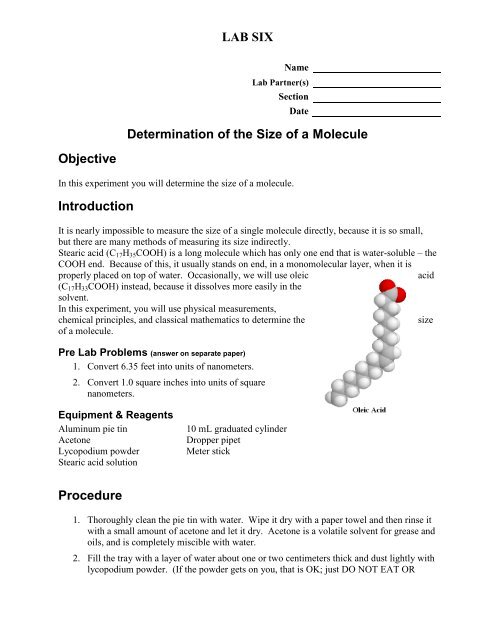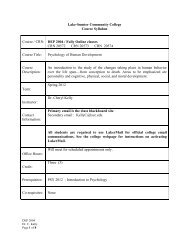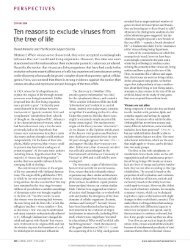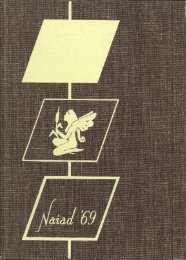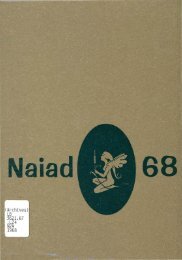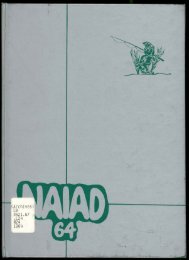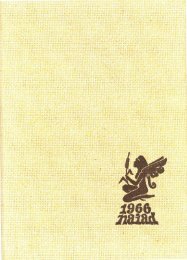LAB 6.pdf
LAB 6.pdf
LAB 6.pdf
You also want an ePaper? Increase the reach of your titles
YUMPU automatically turns print PDFs into web optimized ePapers that Google loves.
Objective<br />
<strong>LAB</strong> SIX<br />
Name<br />
Lab Partner(s)<br />
Section<br />
Date<br />
Determination of the Size of a Molecule<br />
In this experiment you will determine the size of a molecule.<br />
Introduction<br />
It is nearly impossible to measure the size of a single molecule directly, because it is so small,<br />
but there are many methods of measuring its size indirectly.<br />
Stearic acid (C17H35COOH) is a long molecule which has only one end that is water-soluble – the<br />
COOH end. Because of this, it usually stands on end, in a monomolecular layer, when it is<br />
properly placed on top of water. Occasionally, we will use oleic acid<br />
(C17H33COOH) instead, because it dissolves more easily in the<br />
solvent.<br />
In this experiment, you will use physical measurements,<br />
chemical principles, and classical mathematics to determine the size<br />
of a molecule.<br />
Pre Lab Problems (answer on separate paper)<br />
1. Convert 6.35 feet into units of nanometers.<br />
2. Convert 1.0 square inches into units of square<br />
nanometers.<br />
Equipment & Reagents<br />
Aluminum pie tin 10 mL graduated cylinder<br />
Acetone Dropper pipet<br />
Lycopodium powder Meter stick<br />
Stearic acid solution<br />
Procedure<br />
1. Thoroughly clean the pie tin with water. Wipe it dry with a paper towel and then rinse it<br />
with a small amount of acetone and let it dry. Acetone is a volatile solvent for grease and<br />
oils, and is completely miscible with water.<br />
2. Fill the tray with a layer of water about one or two centimeters thick and dust lightly with<br />
lycopodium powder. (If the powder gets on you, that is OK; just DO NOT EAT OR
<strong>LAB</strong> SIX<br />
BREATHE IT.) Since one drop of pure stearic acid would cover much more area than<br />
the tray, it has been diluted in a solvent.<br />
3. Put one drop of the stearic acid solution on the surface of the water using a fine-tipped<br />
dropper pipet. The solvent will evaporate and the stearic acid molecules will spread out<br />
into a monomolecular layer of pure stearic acid, pushing the powder layer as it goes. The<br />
powder outline then defines the limits of the stearic acid.<br />
4. Determine the diameter of the stearic acid ring on top of the water. Use a meter stick to<br />
take six measurements of the outline created by the lycopodium powder. Measure the<br />
‘ring’ in six different directions (measuring through the central point). Find the average<br />
of these six measurements.<br />
5. Repeat steps 1-4 twice more, for a total of three trials.<br />
6. Record the exact concentration of the stearic acid dissolved in the solvent (usually about<br />
0.25 grams per 100 mL). (HINT: It may be helpful to also find the concentration in<br />
moles/L.) From this, you can determine the volume of pure acid in one drop, since pure<br />
stearic acid has a density of 0.9408 g/mL.<br />
7. While you can assume that one mL equals about fifty drops of solution, it is much better<br />
to KNOW what your dropper delivers. Do this by getting a few milliliters of the solution,<br />
filling your dropper pipet, and counting the number of drops it takes to fill up 1 mL in a<br />
10-mL graduated cylinder. It should be in the range of 40-50 drops. Repeat twice more,<br />
and average the three trials. Remember to read the bottom of the meniscus. You will get<br />
better results if you use steady pressure to form the drops and you hold the dropper at a<br />
45° angle.<br />
8. Cleanup<br />
Clean your lab area, pie tin, dropper pipet, and glassware before being signed out.<br />
Calculations<br />
1. Calculate the volume of stearic acid in one drop.<br />
2. Calculate the area of the stearic acid ring.<br />
Remember: Area = π r 2 where Radius = diameter / 2<br />
Also remember Volcylinder = h π r 2
Data<br />
Concentration of acid<br />
<strong>LAB</strong> SIX<br />
Name<br />
Lab Partner(s)<br />
Section<br />
Date<br />
Report: Determination of the Size of a Molecule<br />
Trial 1 Trial 2 Trial 3<br />
# of drops in 1 mL drops drops drops<br />
Average drops/mL drops<br />
Diameter of acid ring Trial 1 Trial 2 Trial 3<br />
(measure 6 times per trial) cm cm cm<br />
cm cm cm<br />
cm cm cm<br />
cm cm cm<br />
cm cm cm<br />
cm cm cm<br />
Average diameter of ring cm cm cm
Calculations<br />
Volume of acid in 1 drop mL<br />
Area of acid ring<br />
Length of molecule<br />
<strong>LAB</strong> SIX<br />
Trial 1 Trial 2 Trial 3<br />
Average length (cm & nm) cm nm<br />
Number of molecules<br />
in the monolayer<br />
Cross-sectional area<br />
of a molecule<br />
Average cross-sectional<br />
area (cm 2 & nm 2 ) cm 2<br />
Width of a molecule<br />
Average width (cm & nm) cm nm<br />
Post Lab Problems (show answers & calculations neatly on separate paper)<br />
Complete these problems for all three trials. All answers must also be recorded on the data<br />
sheet.<br />
1. Using the area of the acid and the calculated volume of the pure stearic acid on top of the<br />
water, calculate the thickness of the monomolecular layer. This should be the length of<br />
the molecule.<br />
2. Knowing that one mole contains Avogadro’s number of molecules (6.02 x 10 23<br />
molecules), propose the other dimensions of the molecule, including the cross-sectional<br />
area and width. (Cross-sectional area of one molecule = area of stearic acid ring /<br />
number of molecules in the monolayer.) Show your reasoning and all calculations.<br />
3. All dimensions of the molecule should be given using centimeters and nanometers. You<br />
may do the calculations in centimeters and convert your average values to nanometers at<br />
the end. Some units have been given for you, but you must provide the remaining<br />
missing units.<br />
nm 2


